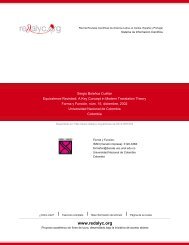Portraits of the spiritual Seeing in Mark's Gospel. Origen ... - Redalyc
Portraits of the spiritual Seeing in Mark's Gospel. Origen ... - Redalyc
Portraits of the spiritual Seeing in Mark's Gospel. Origen ... - Redalyc
Create successful ePaper yourself
Turn your PDF publications into a flip-book with our unique Google optimized e-Paper software.
Jesus and <strong>the</strong> Demons:...<br />
311<br />
perceive <strong>the</strong> notions <strong>of</strong> <strong>the</strong> div<strong>in</strong>e revelation manifested to a human<br />
receptor capable to experience through a physical sensibility <strong>the</strong> div<strong>in</strong>e<br />
manifestations that can awaken <strong>the</strong> <strong>spiritual</strong> sensibility. This sort <strong>of</strong><br />
perception makes every person ontologically capable to elevate oneself<br />
to <strong>the</strong> po<strong>in</strong>t <strong>of</strong> experienc<strong>in</strong>g <strong>the</strong> div<strong>in</strong>e dimension <strong>of</strong> <strong>the</strong> Spirit.<br />
«Accord<strong>in</strong>gly, <strong>the</strong> five <strong>in</strong>dividual sensory senses are but <strong>the</strong> fall and<br />
scatter<strong>in</strong>g <strong>in</strong>to <strong>the</strong> material <strong>of</strong> an orig<strong>in</strong>al and richly abundant capacity<br />
to perceive God and div<strong>in</strong>e th<strong>in</strong>gs. Accord<strong>in</strong>g to <strong>Origen</strong>, <strong>the</strong>se div<strong>in</strong>e<br />
th<strong>in</strong>gs can never be reduced to a mystical unity without modes, but,<br />
ra<strong>the</strong>r, <strong>the</strong>y possess fullness and a glory that far transcend <strong>the</strong> lower<br />
fullness and glory, <strong>of</strong> which material multiplicity is only a distant reflection<br />
and likeness» 7 .<br />
The notion <strong>of</strong> <strong>the</strong> <strong>spiritual</strong> sensibility or senses <strong>of</strong> <strong>the</strong> soul cont<strong>in</strong>ues<br />
to be alive through <strong>the</strong> middle ages, even <strong>in</strong> <strong>the</strong> writ<strong>in</strong>gs <strong>of</strong> <strong>the</strong> Syrian<br />
monks <strong>of</strong> <strong>the</strong> fifth and sixth century, among which is worth mention<strong>in</strong>g<br />
John <strong>of</strong> Apamea who states <strong>in</strong> his second Dialogue with Thomasios <strong>the</strong><br />
need <strong>of</strong> purification from <strong>the</strong> corporeal or terrestrial concerns <strong>in</strong> order<br />
to see <strong>the</strong> <strong>in</strong>visible realities through <strong>the</strong> superior senses <strong>of</strong> <strong>the</strong> soul.<br />
The Syrian Monk speaks explicitly <strong>of</strong> <strong>the</strong> analogy between <strong>the</strong> bodily<br />
senses and <strong>the</strong> senses <strong>of</strong> <strong>the</strong> soul that makes possible for a corporeal<br />
person to perceive <strong>the</strong> <strong>in</strong>visible realities 8 . This notion survived <strong>in</strong> <strong>the</strong><br />
Christian Western Tradition, appear<strong>in</strong>g <strong>in</strong> a more systematic manner<br />
with Bonaventure <strong>in</strong> his It<strong>in</strong>erarium mentis <strong>in</strong> Deum 9 . For Bonaventure<br />
<strong>the</strong> <strong>spiritual</strong> senses are «<strong>the</strong> acts <strong>of</strong> <strong>the</strong> human <strong>in</strong>tellect and will as <strong>the</strong>y<br />
grasp God <strong>in</strong> contemplation – acts which have been restored (refecti),<br />
facilitated (expediti) and brought to perfection (perfecti) by <strong>the</strong> triple<br />
<strong>in</strong>fused habitus <strong>of</strong> <strong>the</strong> “virtues”, <strong>the</strong> “gifts <strong>of</strong> <strong>the</strong> Holy Spirit” and <strong>the</strong><br />
“beatitudes”» 10 . Read<strong>in</strong>g <strong>the</strong>se notions <strong>of</strong> Bonaventure, one can perceive<br />
that <strong>the</strong> division between <strong>the</strong> physical and <strong>spiritual</strong> senses is so subtle<br />
that <strong>in</strong>volves <strong>the</strong> notions <strong>of</strong> virtues, <strong>in</strong>tellect, will, and <strong>in</strong>fused gifts. This<br />
<strong>in</strong>dicates a complete and <strong>in</strong>tegral anthropologic notion, where every<br />
person <strong>in</strong> his/her total and <strong>in</strong>tegral ontological be<strong>in</strong>g has <strong>the</strong> capacity<br />
7<br />
H. U. von Balthasar, The Glory… , 369.<br />
8<br />
Cf. Jean D’Apamée, Dialogue 2,15-16 (SC 311: 59-61).<br />
9<br />
Cf. H. U. von Balthasar, The Glor… y, 371-373.<br />
10<br />
H.U. von Balthasar, The Glory… , 372.
















